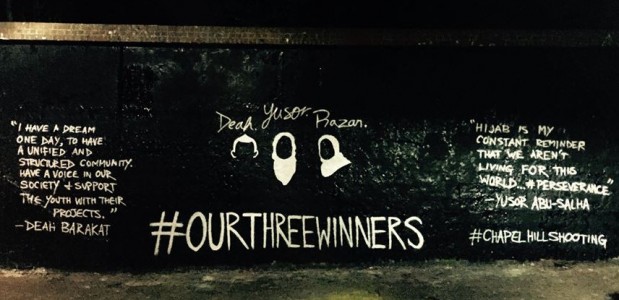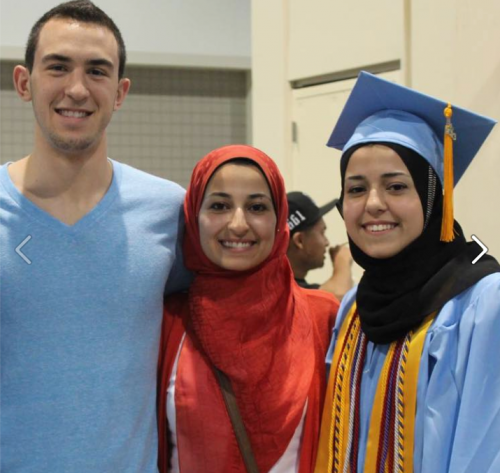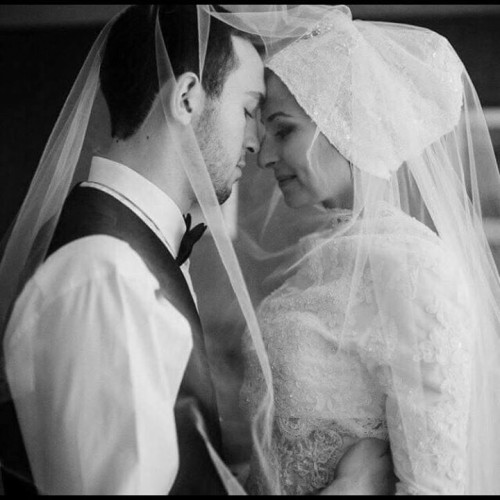
Testimonies from victims’ family members make it clear that Craig Hicks regularly threatened the victims by flashing his handgun at them, made them fearful for their safety, and berated them for their religious identity.
Terrorism is a word with no legal definition, and yet is a word familiar enough to be innately understood by everyone in these conflicted times.
A definition on Wikipedia states that the act of terrorism may be defined as,
“violent acts (or threat of violent acts) intended to create fear, perpetrated for a religious, political, or ideological goal, and which deliberately target or disregard the safety of non-combatants (neutral military personnel or civilians).”
Using this definition then, Hicks sounds like a terrorist, but some news reports have taken great care to exonerate him out of the moral responsibility for his actions. By focusing the lens on the man who chose to murder three innocent students, execution-style, the coverage is dishonoring Deah Barakat, Yosur Abu-Salha and Razan Abu-Salha.

Edina Seferovic, a senior at Athens Drive High School, was devastated by the news. Recollecting her memories of Razan Abu-Salha, she said,
“My heart jumps hearing about Razan…she was a nice and sweet person who cared about everyone and never had a bad thing to say about others.”
Seferovic’s eldest sister, Amra Seferovic, had class with Yosur Abu-Salha, which is how the younger sisters met. Amra went on to say that the siblings were, “smart, active in school and could cheer anyone up.”
[Read Related: The Media’s Double Standard in Reporting the Murders of the Chapel Hill Muslim Students]
The three victims attended North Carolina State University for their undergraduate education. Barakat was a second year Dental Surgery student at University of North Carolina – Chapel Hill and was married to Yosur, who was planning to study there in the upcoming fall semester.

[Photo Source: Facebook.com/ourthreewinners]
“Barakat was a competitor and he wanted to be the best at what he did…it was not only displayed on the basketball court; this was his way of life.”
It was a trait that carried outside the court as well. Reflecting on their mission work, Freeman especially admired the passion Barakat and his wife, Yosur, demonstrated in promoting dental care in Syria.
Edina is angered by the media coverage of the tragedy.
“The media to me, is focusing more on the suspect then the three young adults killed that day, and if they were killed due to a parking dispute, then that really is a shame. Their lives were too priceless for a parking spot,” she said.
However, in examining the way the victims were killed, it would appear that this was not a crime of passion. All the victims bore gunshot wounds to the head; signs usually indicating execution style assault. It would appear Hicks was a man with a plan, with a view to kill.
Both Freeman and Seferovic can’t believe that the incident occurred in the way it has been reported. Freeman, continues to dwell on the positive memories and believes that “we all have to answer to God one day and will be held accountable for our actions.”
Whether or not this was a hate crime, or a dispute-gone-sour over parking, the murders of these three young people has left the local community shaken, especially those who are Muslim. For many of them, this is simply an act of terror, being justified by authorities terming it a dispute over parking.
The complaints are not just against indifferent authorities. The popular media outlets appear just as much a party to this flagrant indifference, with its refusal to question the crime reports and investigating below the surface. There has been a visible lack of any kind of investigative journalism.
Most media reports remain focused on the suspect’s life, instead of honoring the victims’ lives. The media has also resorted to crass reporting that has broken several ethical standards. One example is a flagrant report on how to find a parking space, prefacing the story with the Chapel Hill tragedies.
In fact, after referencing the Society of Professional Journalists’ handbook of ethics, the media has broken several ethical standards, by not seeking the truth in news gathering, and by not reducing harm in the coverage of victims.
It would appear that the media has a color-coded definition for murderers. Black suspects are often made into hardcore street-criminals; Middle-Eastern/South Asian suspects are often made into brainwashed terrorists, but white suspects are usually painted as lone wolves, and often “mentally-ill.”
The Sentencing Project, a non-profit group that advocates for social justice, cited a study that found:
“whites represented 43 percent of homicide victims in local news, but only 13 percent of homicide victims in crime reports. And while only 10 percent of victims in crime reports were whites who had been victimized by blacks, these crimes made up 42 percent of televised cases.”
The group cites stereotypes perpetuated by the mass media as contributing factors to cultural ignorance.
Now, let’s not forget Timothy McVeigh, responsible for the 1995 Oklahoma Bombing, and Wade Page, who was responsible for the Wisconsin Sikh temple shooting in 2012. Terrorists emerge from extremist mentalities, and extremists exist in every ideological belief.
President Barack Obama addressed this fact, but was met with widespread criticism for his candid commentary. At the Prayer Breakfast, Obama eloquently stated, “In our home country, slavery and Jim Crow all too often were justified in the name of Christ.”
[Read Related: The Conflict of a Twenty-Something Muslim in America, Post Chapel Hill Shootings]
People fight over whether God exists; people fight over the existence of one or many Gods; people fight over prophets. Instead of fearing and hating what we do not understand, we must learn to love and respect differences in humanity. After all, the beauty of this world is that it is not just black and white, but instead beautiful shades of every color.
If nothing more, this Southern community has started spreading the message of unity and benevolence that Barakat and the Abu-Salha sisters lived by. Hopefully, the inspiration from our three North Carolina winners can grow into a larger paradigm shift of secularism and tolerance.
More importantly, let’s accept that terrorism and terrorists are not defined by the color of their skin, but by their blatant disregard for human life, and an intolerance for difference of opinion, faith and belief.
[divider]
 Karishma B. Desai freelances for the award-winning IndyWeek, is starting as an overseas contributor to the Bangalore Mirror and was a former intern for UNC-TV (North Carolina’s PBS Affiliate). When she’s not writing articles at Starbucks, you can find her videotaping a new adventure for YouTube or interviewing inspirational people for a documentary. She is a city girl who is working towards her dreams of becoming a TV health/science reporter.
Karishma B. Desai freelances for the award-winning IndyWeek, is starting as an overseas contributor to the Bangalore Mirror and was a former intern for UNC-TV (North Carolina’s PBS Affiliate). When she’s not writing articles at Starbucks, you can find her videotaping a new adventure for YouTube or interviewing inspirational people for a documentary. She is a city girl who is working towards her dreams of becoming a TV health/science reporter.




